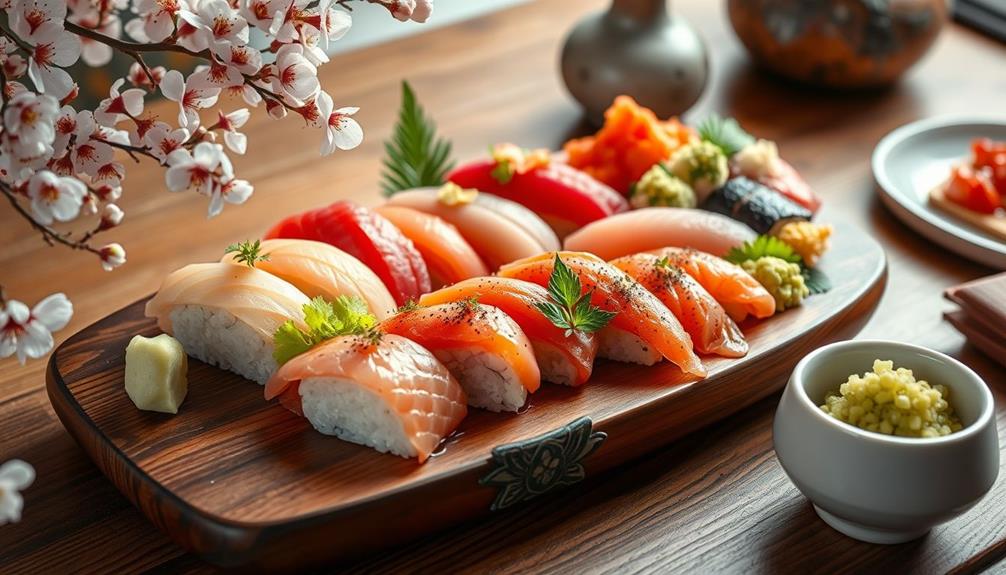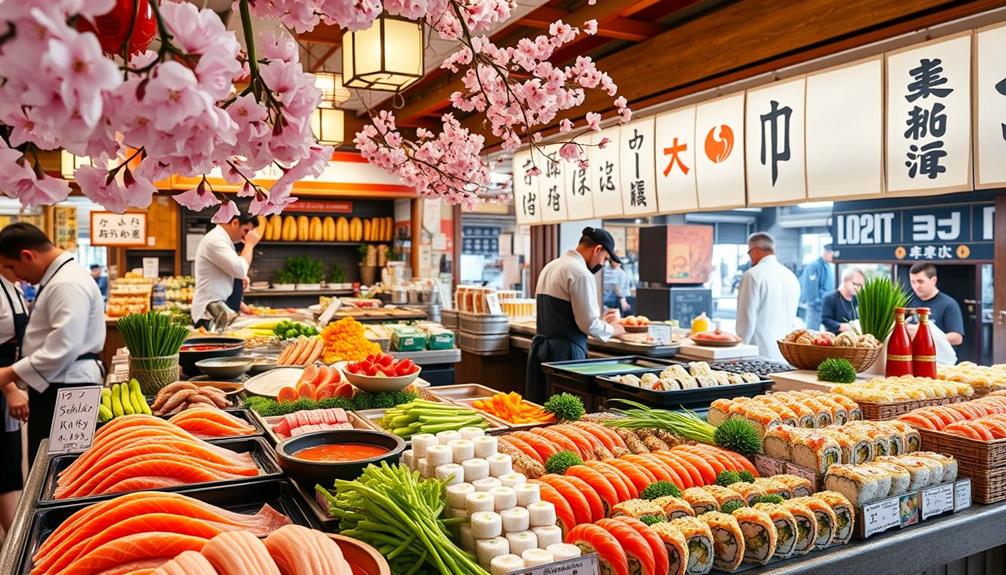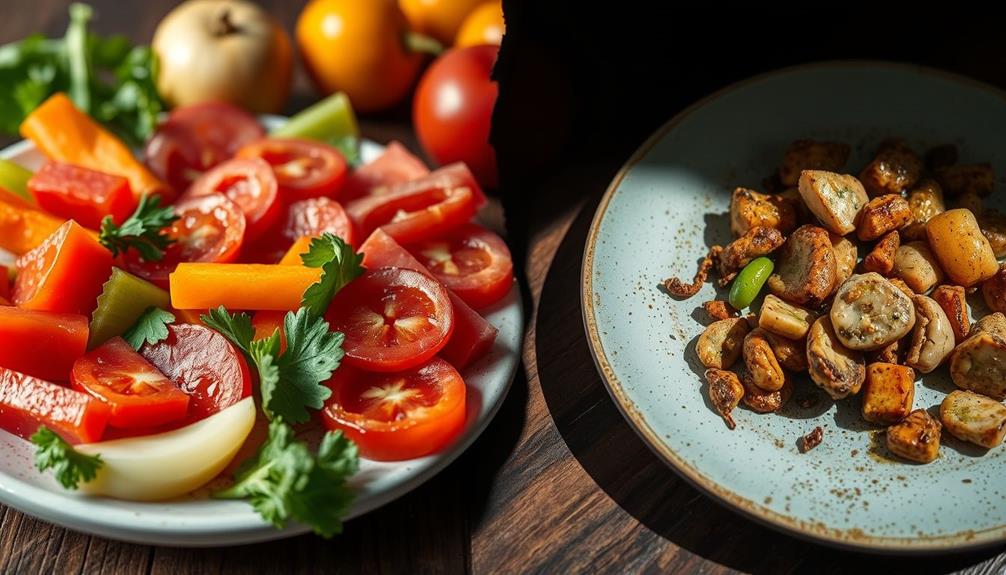Japanese people eat raw food because it's deeply rooted in their culture and history. Influenced by Shinto beliefs around purity, they've embraced raw ingredients like sushi and sashimi for centuries. You'll find strict hygiene practices in food preparation, ensuring safety while enjoying fresh flavors. Unique seasonal offerings highlight the importance of vibrant taste and freshness in their cuisine. Health benefits also play a role, with raw fish providing essential nutrients and omega-3 fatty acids that support overall well-being. Curious to learn how these traditions shape modern dining trends? There's much more to explore about Japan's raw food culture. However, it’s important to note that consuming raw food can also pose potential health risks. Certain types of raw fish and meat may contain harmful bacteria and parasites that can lead to foodborne illnesses. This is why raw food is unsafe for certain individuals, such as pregnant women, young children, and those with compromised immune systems. Despite these risks, the Japanese have developed and maintained meticulous preparation techniques to minimize the chances of foodborne illness and continue to enjoy the unique flavors and health benefits of raw cuisine.
Key Takeaways
- Raw food consumption in Japan is influenced by Shinto beliefs emphasizing cleanliness, purity, and respect for nature's offerings.
- Buddhist teachings promote the preference for fish over red meat, impacting traditional dietary choices and practices.
- Japan's island geography has historically prioritized seafood, leading to the evolution of dishes like sushi and sashimi.
- Strict hygiene and innovative safety practices ensure the consumption of raw ingredients is safe, highlighting the importance of food quality in Japanese cuisine.
- Seasonal ingredients and natural flavors are key to Japanese culinary practices, enhancing the appeal of fresh, raw dishes for health-conscious diners.
Cultural Significance of Raw Foods
When you explore the cultural significance of raw foods in Japan, you'll find that the practice is steeped in historical and spiritual traditions. The consumption of raw fish is deeply embedded in Japanese cuisine, reflecting the Shinto beliefs surrounding cleanliness and purity.
This reverence for fresh seafood aligns with Buddhist teachings, which often promote fish over red meat, seen as impure due to its association with blood and death. The attention to detail in food preparation, including the use of fresh ingredients, can be compared to the importance of cold medications overview in ensuring health and well-being.
Japan's island geography has shaped its culinary practices, making fish a primary food source for centuries. As a result, raw fish has become a dietary staple, celebrated for its unique flavor and texture. Dishes like sushi and sashimi not only showcase the freshness and quality of the ingredients but also embody the cultural appreciation for simplicity and artistry in food presentation.
Additionally, spiritual beliefs about purity contribute to the importance of seafood in daily meals, intertwining food practices with broader societal values. This deep-rooted connection between raw fish and cultural identity highlights how food in Japan isn't just sustenance but a reflection of historical and spiritual significance.
Historical Context of Raw Cuisine

Raw cuisine in Japan has a rich historical context that spans centuries, reflecting the nation's deep connection to its marine resources. Japan's island geography made fish a primary food source, so it's no surprise that raw fish has been a staple in Japanese food traditions. Ancient dietary customs included consuming raw fish, which eventually evolved into popular dishes like sushi and sashimi.
Over time, various cooking methods for fish were developed, but the focus on raw preparation became prominent due to the appreciation for freshness and quality. Additionally, trade and cultural interactions with other nations influenced the acceptance of raw foods, enriching Japan's culinary practices. Historical texts even reference the consumption of raw vegetables, showcasing a long-standing tradition of enjoying fresh, uncooked ingredients.
Here's a quick comparison of raw cuisine's evolution:
| Aspect | Historical Context |
|---|---|
| Primary Ingredient | Raw Fish |
| Key Dishes | Sushi, Sashimi |
| Cultural Influence | Trade and Interaction |
This historical backdrop underscores why raw cuisine remains a celebrated aspect of Japanese food culture today.
Safety Practices for Raw Consumption

When it comes to enjoying raw food in Japan, understanding hygiene and sanitation standards is essential.
The emphasis on fresh ingredients and meticulous preparation techniques, similar to those seen in hamster care guidelines, plays a significant role in ensuring the safety of these dishes.
You'll find that innovative processing techniques play a significant role in ensuring the safety of these dishes.
Hygiene and Sanitation Standards
Guaranteeing safety in raw food consumption is essential in Japan, where strict hygiene standards are upheld at every stage of food preparation. The Japanese Health Ministry mandates thorough washing and sanitization of all raw ingredients, which greatly reduces the risk of foodborne illnesses.
For instance, eggs must undergo rigorous inspection and disinfection before they can be safely consumed raw in dishes like tamagokake-gohan. Additionally, awareness of food safety practices is vital, much like the importance of early detection in mammography guidelines.
Seafood processing facilities also implement stringent protocols, including voluntary testing for pathogens such as norovirus. This diligence assures that the raw fish served in sushi and sashimi meets high safety standards.
Additionally, traditional condiments like wasabi and fermented sauces, such as soy sauce, not only enhance the flavor profile but also possess antibacterial properties that inhibit bacterial growth in raw foods.
Moreover, local manufacturers are embracing innovative techniques to further guarantee safety. For instance, using pulse power to eliminate anisakis parasites in fish is becoming more common.
These combined practices reflect Japan's commitment to hygiene and sanitation, allowing you to enjoy raw food with peace of mind, knowing that safety is always a top priority.
Innovative Processing Techniques
As the demand for raw food continues to rise, innovative processing techniques are becoming vital for maintaining safety and quality. Companies like Japan Seafoods utilize pulse power to eliminate parasites from raw fish while preserving its appearance, taste, and texture. This method guarantees that the sashimi you enjoy isn't just delicious but also safe to eat, reducing the risk of food poisoning.
Additionally, maintaining proper hygiene in food preparation areas is essential, akin to the air purifier maintenance dos and don'ts that emphasize cleanliness and efficiency.
Moreover, electrical currents applied to saltwater tanks further enhance safety by effectively treating the fish. In addition to these technological advancements, Japan's Health Ministry enforces stringent sanitation measures for raw egg consumption. Eggs undergo thorough disinfection and inspection before reaching your table, which is vital for preventing any health risks.
The development of cold chain systems in Japan is also significant. These systems maintain safe temperatures for raw foods, guaranteeing freshness from production to consumption.
Specific regulations, particularly in Hiroshima Prefecture, oversee oyster farming for raw consumption, requiring farmers to report to health centers and undergo voluntary safety testing.
These innovative processing techniques and strict regulations collectively help you enjoy raw food with confidence, knowing safety is a top priority.
Taste Preferences and Culinary Trends

When you think of Japanese cuisine, the emphasis on flavor and freshness stands out, especially in dishes like sushi and sashimi.
These culinary trends aren't just rooted in tradition; they're evolving with global tastes and seasonal ingredients.
The balance of aesthetics and taste in Japanese cooking often mirrors the importance placed on quality and service in the coffee industry, where various brewing methods considerably impact flavor profiles.
As you explore these raw food options, you'll notice how social media amplifies interest and appreciation for these vibrant flavors.
Flavor and Freshness Appreciation
In Japanese cuisine, the appreciation for flavor and freshness isn't just a preference; it's a cultural cornerstone. You'll notice that the emphasis on fresh ingredients is paramount, especially when you eat raw fish in dishes like sushi and sashimi. This deep-rooted cultural value stems from Japan's historical reliance on seafood, making raw fish a dietary staple for centuries.
The use of natural ingredients extends to the incorporation of essential oils in various aspects of culinary practices, such as using essential oils for enhancing flavors in dishes.
Seasonal availability plays a vital role in shaping the types of raw dishes you encounter. Chefs highlight the best catches of the season, ensuring that the flavors are as vibrant and distinct as possible.
When you indulge in raw food, you'll find that strong flavors from fermented condiments like soy sauce and wasabi elevate the taste, while also providing antibacterial benefits, enhancing your dining experience.
The global interest in sushi and sashimi reflects a wider appreciation for the clean and delicate flavors of raw ingredients. As you explore Japanese cuisine, you'll appreciate how this cultural cornerstone not only celebrates freshness but also creates a unique culinary experience that resonates with people around the world.
Evolving Culinary Trends
Evolving culinary trends have reshaped how you experience Japanese raw food, blending traditional flavors with modern tastes. The appreciation for freshness drives your love for sushi and sashimi, but these dishes have also found new life through fusion cuisine. As health-conscious dining rises, raw food becomes increasingly popular, with omega-3 fatty acids from raw fish topping many health lists.
Your taste preferences are influenced by seasonal ingredients, as locals prioritize high-quality fish for raw preparations. The global interest in Japanese cuisine has expanded the acceptance of raw dishes, making sushi and sashimi widely sought after even outside Japan.
Here's a quick look at some evolving trends in raw food:
| Trend | Description | Example Dish |
|---|---|---|
| Fusion | Combining traditional Japanese with other cuisines | Sushi burrito |
| Health-focused | Emphasizing nutritional benefits of raw food | Sashimi salad |
| Seasonal sourcing | Prioritizing local, fresh ingredients | Omakase-style sushi |
Health Benefits of Raw Ingredients

Raw ingredients in Japanese cuisine offer a wealth of health benefits that can enhance your overall well-being. When you consume raw meat and fish, you're getting essential proteins and fats that cooking can diminish. This means you're maximizing the nutritional value of your meals.
For instance, the omega-3 fatty acids found in raw fish support heart health and help reduce inflammation, making it a smart choice for your diet. Additionally, raw foods are typically low in calories but high in vitamins and minerals, contributing to a balanced diet. Notably, certain raw juices, like celery juice, are known for their anti-inflammatory properties, which can complement the benefits of raw foods.
Pairing raw ingredients with fermented sauces like soy sauce introduces antibacterial properties that promote gut health and digestion, further enhancing the health benefits of your meals.
Moreover, eating raw foods allows you to experience the unique flavors and textures of fresh ingredients, enriching your culinary experience. By appreciating the freshness of these ingredients, you're not only nourishing your body but also enjoying a sensory delight.
Embracing raw ingredients in your diet can lead to significant health benefits and a deeper connection to the foods you consume.
Innovations in Raw Food Processing

Advancements in raw food processing are transforming how we enjoy traditional Japanese cuisine. Innovations in raw food processing have made it safer to eat raw ingredients while preserving their unique flavors and textures. For instance, Japan Seafoods uses pulse power technology to eliminate parasites from raw fish, guaranteeing it's safe to eat without compromising quality.
Additionally, electrical currents in saltwater tanks are being trialed to enhance the safety of sashimi. Strict sanitation practices for raw egg consumption, mandated by the Health Ministry, further reinforce food safety. Cold chain systems maintain freshness, while regulatory frameworks, like those in Hiroshima Prefecture, enforce safety protocols for raw shellfish.
Here's a quick overview of these innovations:
| Innovation | Purpose |
|---|---|
| Pulse power technology | Eliminate parasites from raw fish |
| Electrical currents in saltwater | Enhance sashimi safety |
| Cold chain systems | Maintain freshness of raw seafood |
These cutting-edge methods guarantee that you can enjoy your favorite dishes with peace of mind, knowing that safety measures are in place to protect your health.
Frequently Asked Questions
Why Japanese Food Is Important to the Culture?
Japanese food's important to the culture because it reflects seasonal ingredients, emphasizes freshness, and showcases artistry in presentation. You'll find that meals often connect deeply to historical practices and community traditions, enriching the dining experience.
Why Is Sushi Important to Japanese Culture?
They say you eat with your eyes first. Sushi's importance in Japanese culture lies in its artistry, fresh ingredients, and historical ties to seafood, showcasing the nation's appreciation for aesthetics and seasonal flavors in every bite.
Why Do Japanese People Like Sushi so Much?
You'll love sushi for its fresh flavors and delightful textures. The artistry in its presentation enhances your dining experience, while its cultural roots make each bite a connection to Japan's rich culinary history.
Why Do Some Cultures Eat Raw Meat?
Some cultures eat raw meat because they believe it enhances flavor and freshness. You'll find that traditions, geographical access to quality ingredients, and culinary practices shape these dietary choices, creating unique and celebrated culinary experiences.
Conclusion
So, next time you're contemplating dinner, remember that while you might find sushi a bit too "bare," the Japanese see it as culinary artistry. Why bother with cooking when you can indulge in the freshest flavors straight from the ocean? Sure, you could toss your steak on the grill, but that's just so last season. Embrace the raw revolution—after all, if it's good enough for the sushi-loving samurai, it's probably good enough for you too!










